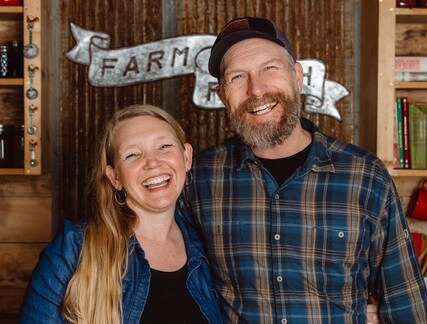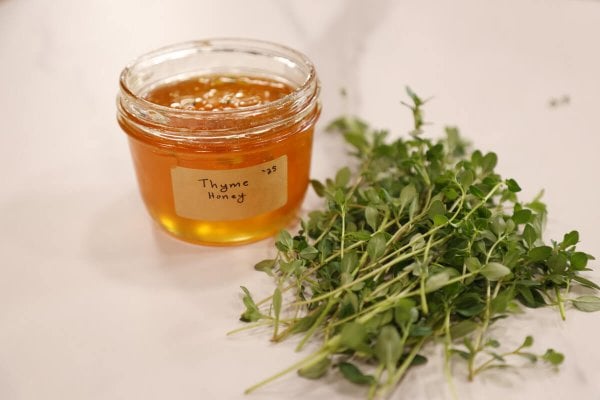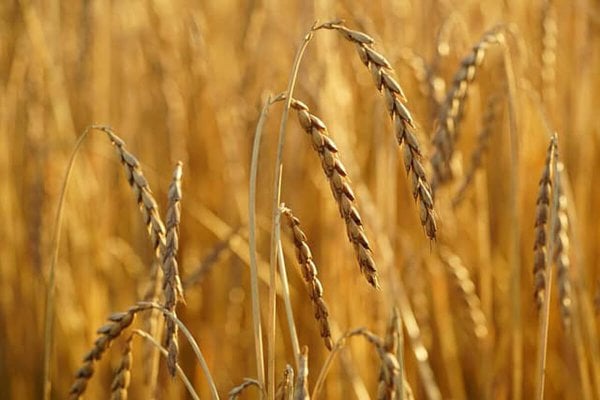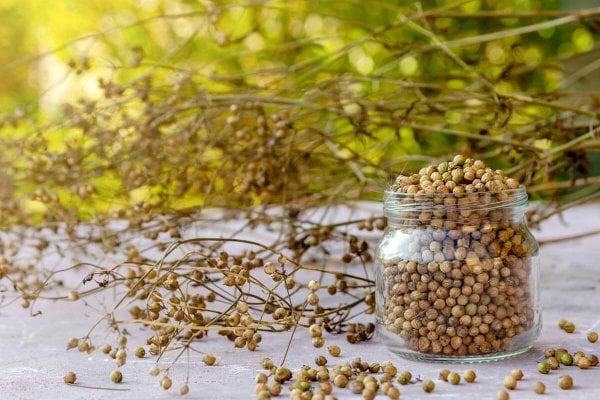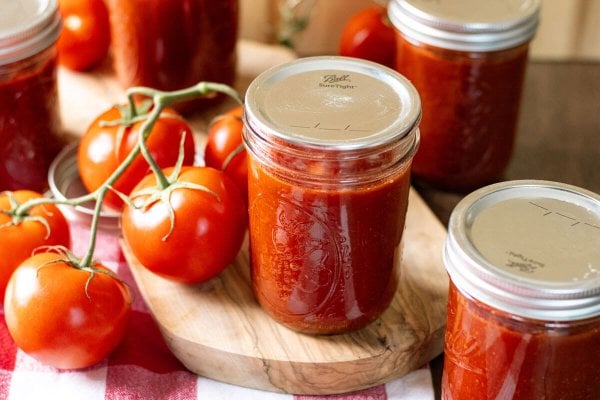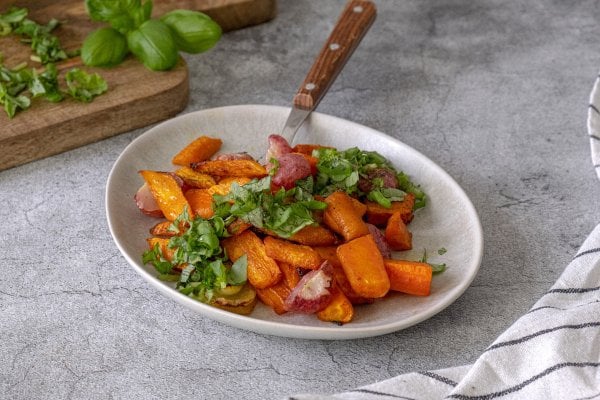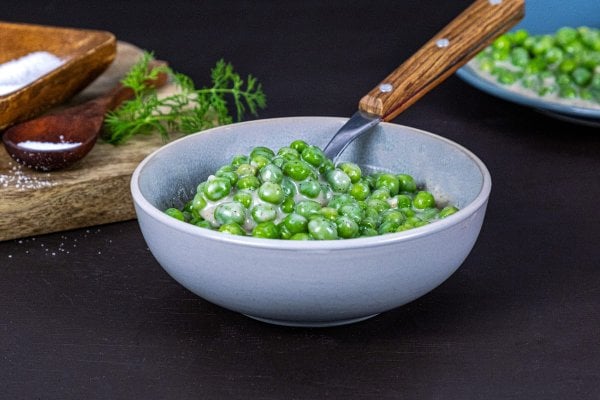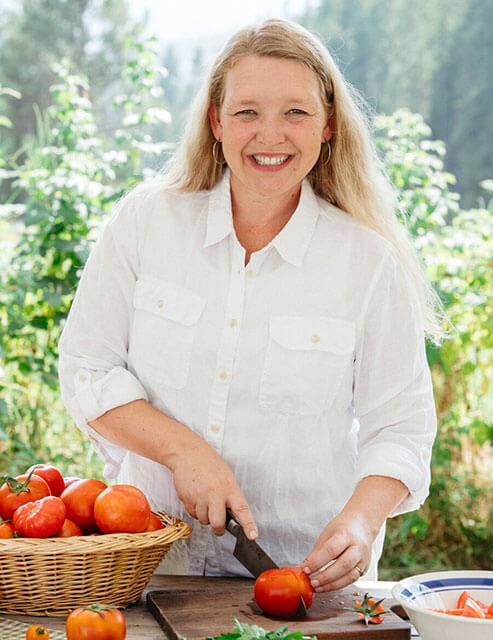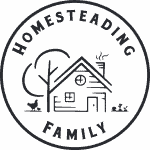


Learning how to raise a year’s worth of meat is pivotal in building resiliency on the homestead. The good news is that there are many ways to go about this. Read through this post to learn how much meat your family needs for a year, including how many animals that amount of meat equates to.
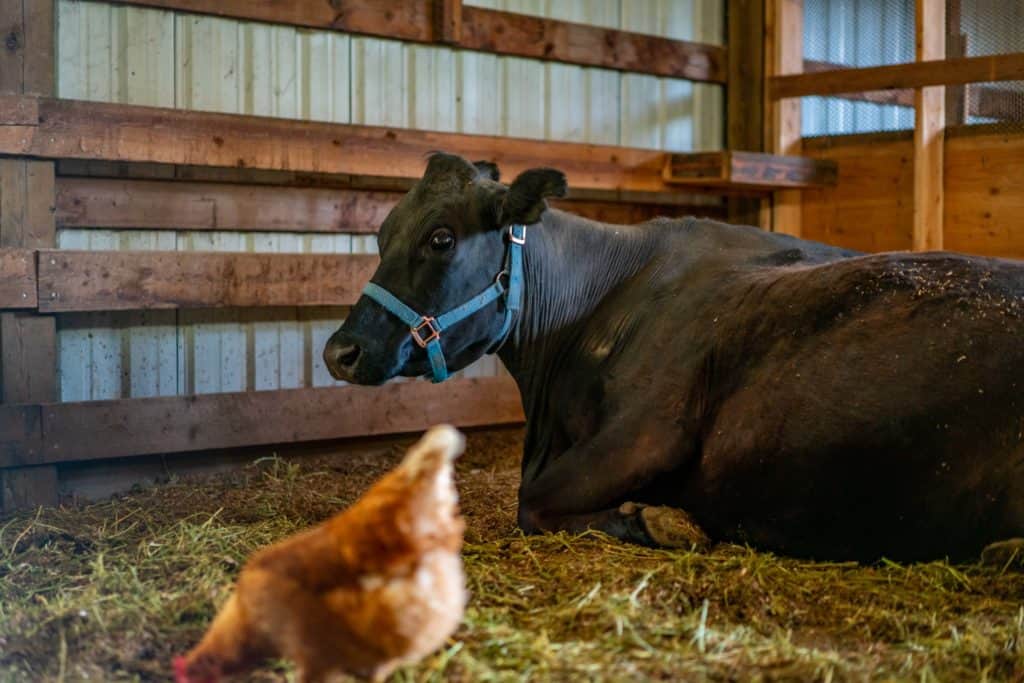
Remember that when we’re talking about raising a year’s worth of meat for our family, we’ll need much more than the average family. We are two parents with eleven children, and we feed two or three extra people most days of the week.
The first step in knowing how to raise a year’s worth of meat is to know just how much your family consumes. We’ve given you a basic formula below, but this will be the first step in knowing how many animals you need to raise per year.
The information in this post will also be helpful for those not yet raising their meat (to know how much to buy when purchasing meat from the grocery store, local farmer, etc.) and be able to budget and plan.
Furthermore, if you’re looking to start a homestead in the future, choosing the best homestead animals and knowing how many animals your family will eat in a year is good information when figuring out just how much land you’ll need to raise those animals (Homesteading Hack: It’s probably not as much land as you may think! We’re on 40 acres, but only actively using about four of those acres to raise our animals, grow gardens and keep our orchards.)
How Much Meat Do You Need?
Deciding to raise meat animals is an excellent step towards resiliency. However, before investing time, money, and effort into breeding and raising animals for meat consumption, it’s crucial to determine how much meat you need to raise, how many animals are required, and the time duration involved.
When deciding how much meat to raise, consider factors such as the size of your family, meat consumption per person per day, and any anticipated events or guests.
The general rule of thumb is to raise 1/4-1/2 pounds of meat per person per day. This equates to 1.75-3.5 pounds of meat per person per week. So, a family of four would require 7-14 pounds of meat per week, or 364-728 pounds of meat per year.
| # of People in the Household | Pounds of Meat Per Year (1/2 lb per day) |
|---|---|
| 1 | 182 |
| 2 | 364 |
| 3 | 546 |
| 4 | 728 |
| 6 | 1,092 |
| 8 | 1,456 |
It’s also important to consider the time commitment needed to raise and care for the animals until they reach the desired weight. Chickens can be raised within a couple of months, while pigs take much longer, typically up to eight months or more. Cows take upwards of two years or more, depending on breed and size.
Finally, planning is crucial when it comes to meat-raising goals. Take the time to calculate the pounds of meat required, determine the number and type of animals needed, and assess the overall time commitment needed to reach your goals.
When considering these factors, you can confidently determine how much meat to raise and create a realistic plan to achieve your meat-raising goals. Then, you can begin to think year-over-year by breeding animals to reduce the overall cost.

How Much Meat Our Family Raises
- Meat Chickens – We raise anywhere from 150-200 meat chickens annually. In our family, we eat three chickens per week. One hundred fifty chickens yield approximately 875-1,050 pounds of chicken. (Learn how you can reduce chicken feed costs in any climate.) We then save the bones, feet, necks and heads to turn into homemade bone broth.
- Beef Cattle – We harvest two 1,200-pound steers, yielding approximately 984 pounds of beef.
- Pigs – We’ll butcher four 250-pound pigs, yielding approximately 530 pounds of pork. We love our Kune Kune pigs. We chose this heritage breed because they’re known for their lard. This is great for us since we often cook with our home-rendered lard.
- Sheep – We butcher one 100-pound sheep, yielding approximately 42 pounds of lamb. We used to raise more. However, we’ve found that, for our liking, we prefer eating beef more often than lamb, so we increased our beef and decreased our lamb production (however, we always raise more than one because they’re happier animals this way).
- Turkeys – We always raise a few turkeys each year. One for the Thanksgiving day spatchcock turkey, then a couple of others to either roast and eat whole or can for the pantry. Our son also raises extra turkeys to sell in the fall.
- Geese – We have a free-ranging pair of geese on our homestead that generally breed each year. So, we’ll usually butcher a few geese throughout the year.
- Salmon – Carolyn has found some family-owned companies that travel to Alaska each year, fish for salmon, flash-freeze the meat and then bring it back down to our area to sell. This is considered a treat for us, not something we’re consuming on a weekly basis.
- Hunting & Fishing – We then fill in the gaps by hunting for deer and elk and some fishing throughout the year.
All in all, this adds up to about 1,500 to 2,000 pounds of meat each year for our family.
It goes without saying, but 1,500 pounds of meat does not equate to 1,500 pounds of animals. We must understand the difference between live, hanging, and cut weights. On average, you can expect the difference between live and cut weight to be about 1/3. This is a VERY ROUGH rule of thumb and is based on butchering and feeding practices.
It’s very important to run true numbers based on the actual percentages below (see graph) to check that you’re getting the right amount of meat for your family and from your animals.
Again, as a rough estimate, whatever the amount of meat you want to eat yearly, you’ll want to multiply that by three. For example, if your family consumes 1,000 pounds of meat a year, you’ll need approximately 3,000 pounds of live weight distributed between your animals (excluding poultry but including hogs, lamb, game meat and beef).
Understanding Terminology
Live Weight
Live weight is the weight of the animal at the time of butchering. Or what the animal weighs “on hoof.” This is not the final weight of the animal or how much meat the animal will provide.
Remember, the animal has skin, bones, blood and other parts that all add up to that live weight. We’re all for utilizing as much of the animal as possible, which is why we always save the bones for making broth, the blood, feathers and any other waste to add to our compost pile. (Learn more about adding meat and blood to your compost here.)
Homesteading Hack: Save the highly nutritious organ meats and learn how to prepare them for even more cost benefit. Start by making homemade organ meat seasoning or Savory Beef Tongue (Fajitas de Lengua).
Our hope is that nothing from the animal is wasted.
Hanging Weight
The hanging weight (also called the hot carcass weight) of an animal is the weight after slaughter but before butchering. This is the weight once the bowels, organs, skin, and usually, the head have been removed and the blood drained from the animal.
When using a butcher, this is the weight they’ll use for their processing fees (how much per pound they charge for butchering).
Cut Weight
The cut weight is the actual take-home weight of the animal. Keep in mind that many animals will still have bones (such as chickens, turkeys, rabbits, and even certain cuts of beef or pork), so you’ll need to take this into consideration in your annual amount of meat.
Percentage of Live Weight to Cut Weight
The real trick when figuring out how many animals to raise for a year’s worth of meat is to know the difference between the live and cut weight. Then, you can reverse-engineer to know how many animals you need to raise (or purchase) each year.
The chart below lists averages based on commercial meat breeds. If you’re working with heritage breeds, understand that the percentages will be on the lower end. Do your research based on the breed you’re interested in.
| Animal | % of Live Weight to Cut Weight | Live Weight by Animal |
|---|---|---|
| Beef Cow | The cut weight of a cow will be about 41-50% of the live weight. | 1200 pounds |
| Pork | The cut weight of a pig/hog will be about 53-60% of the live weight. | 250 pounds |
| Lamb, Venison, Elk | The cut weight of lamb, venison or elk will be about 35% of the live weight. | 120 pounds |
A few things will affect the percentage of cut weight from an animal, such as the breed, how the animal was raised and finished, if your animal was unhealthy, or if you exclude a lot of bones.
Ways to increase this yield are to finish out your animals properly, learn the basic principles of raising happy, healthy animals (like the deep bedding method), and learn how to butcher meat yourself. When we butcher our meat, the percentage of our meat yield is always on the higher end.
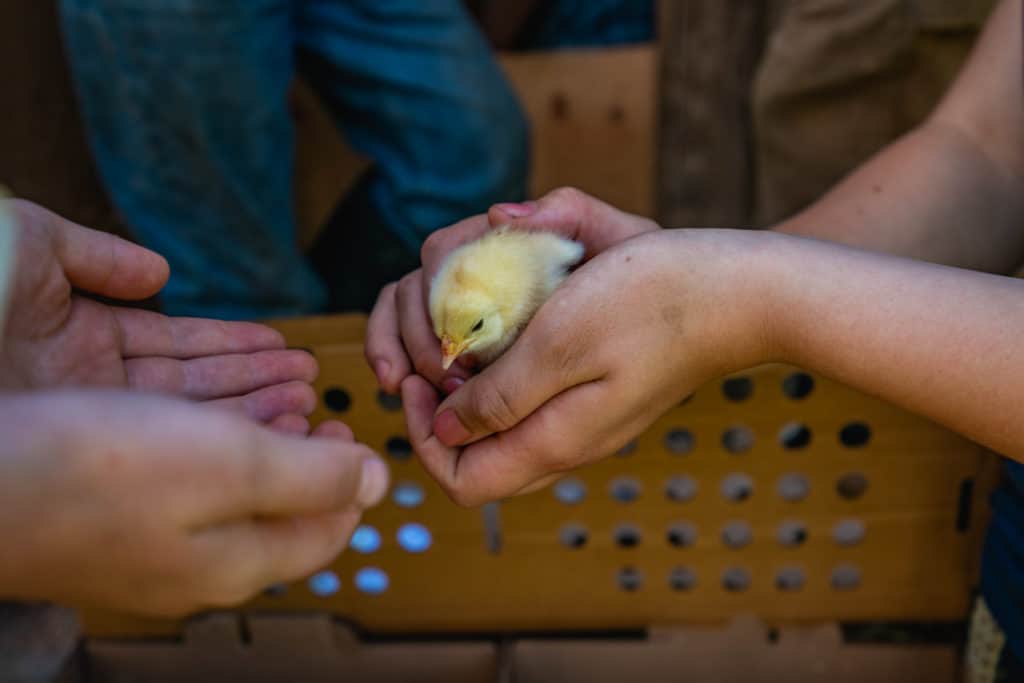
What Kinds of Meat Can Be Raised?
Meat Chickens
First on our list of meat to raise at home are chickens. They’re considered the “gateway” animal because they’re fairly easy to raise, take up very little space, and can be raised in about 8-12 weeks.
Raising 60-70 chickens will give you approximately 400 pounds of meat. You can raise this many chickens in about two chicken tractors or one Happy Farmer Mobile Chicken Coop. Learn more about raising meat chickens. Be sure to give yourself about 15% padding and order more birds than your end goal because you will lose some.
Don’t forget about butchering expenses! Chickens are fairly easy to butcher yourself, however, it does require specialty equipment. If you don’t already have this equipment, take that into account. There are some areas where you can rent chicken butchering equipment for a weekend which is a great option when getting started.
If you’re looking to invest in chicken butchering equipment, this will add up to another couple thousand dollars. It will eventually pay for itself, but it’s an upfront investment that often goes overlooked. Our recommendation is to invite friends and family for a chicken butchering day where you all pitch in. Many hands make light work, then you can send your volunteers home with a few chickens for their efforts.
Meat Rabbits
If space is a major concern then raising meat rabbits might be best for you. Rabbits reproduce very quickly, so you will have a constant supply of meat that doesn’t all need to be butchered at once.
If you want more information, we highly recommend checking out Daniel Salatin’s knowledge on raising meat rabbits.
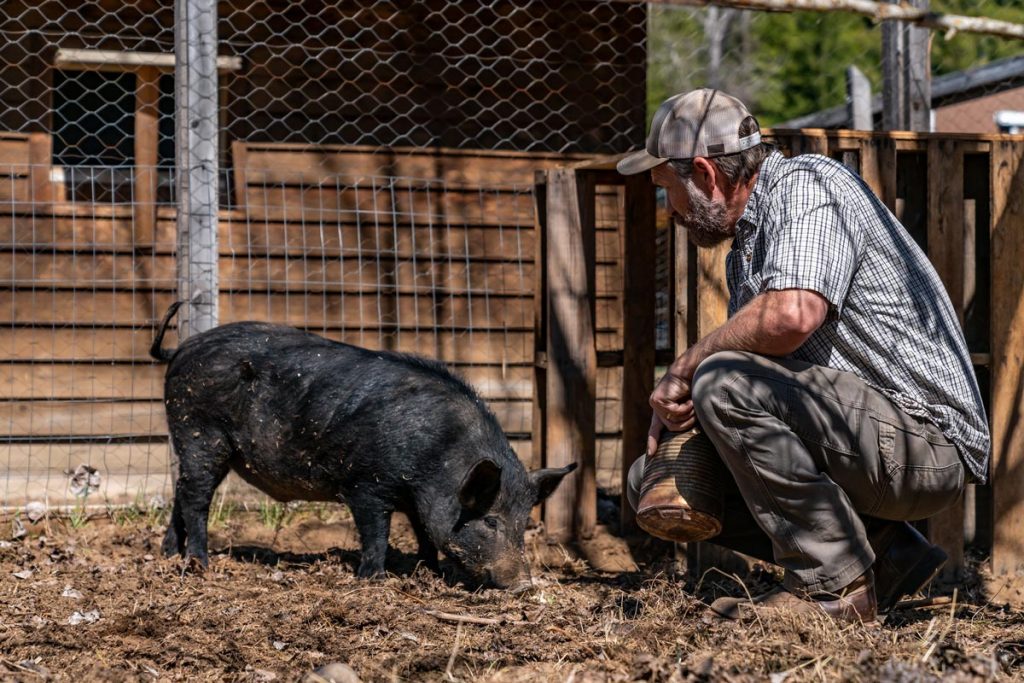
Pigs
From chickens or rabbits, the next best step in raising backyard meat is pigs. You can pasture pigs, but you don’t have to, so if you’re limited in space they’re still an option.
They’re very easy to raise, and you get a good variety of meat and lard from one animal. The lard allows you to start replacing oils and butter in your cooking, so it’s a great dual-purpose animal.
Pork can also be cured very easily (learn how to cure bacon here) and, therefore, can be stored long-term without the need for refrigeration or additional preservation supplies.
Pigs can also be fed a wide variety of foods like kitchen scraps, excess milk from the dairy cow or whey leftover from cheese-making.
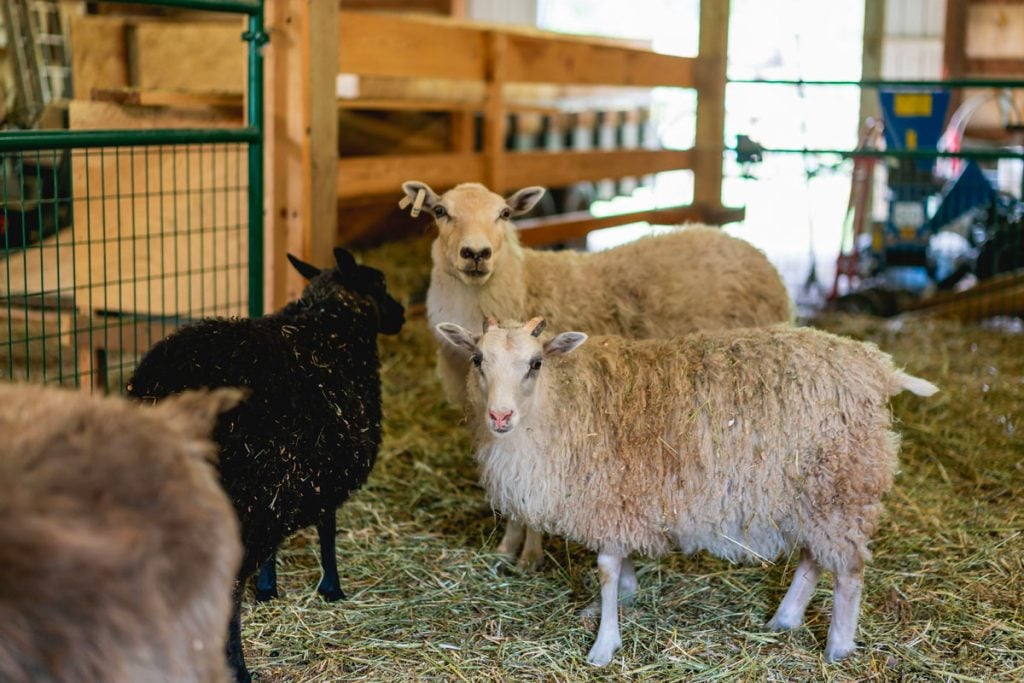
Sheep & Goats
If you’ve had lamb or goat meat in the past and you have the opinion that you don’t like them, try some home-raised lamb and goat before writing them off as a possible meat animal to raise.
Sheep are easy to handle and don’t require too much space for shelter, but you will want to have some pasture for them to graze.
A word of caution on both sheep and goats. Sheep will get themselves stuck in anything and everything they can. They’re very curious animals, and that often leads to stuck situations (for a good laugh, be sure to click that link to see one of our sheep with its head stuck in a bucket!).
Goats, on the other hand, will try to climb anything and everything they can. They have a natural tendency to climb, so be sure to anticipate that and even give them places to climb to keep them happier.
Goats can survive on pasture, but they’re actually browsers and do well in areas where they can browse.
Goats can be a great dual-purpose animal if you’re looking for both milk and meat. Check out this podcast we did with Anne of All Trades about raising goats for milk and this post for a delicious chevre cheese recipe.

Beef
Just because the animal is bigger doesn’t mean it’s harder to raise! Sometimes cattle can be easier to keep contained and fed than many of the other animals. However, they do require adequate space to graze.
Angus steers are generally more high-strung than many other breeds of cattle, so we no longer raise this breed and now stick with Herefords.
Remember that a steer will take a couple of years to raise, so plan accordingly and keep your herd growing each year.

Hunting & Fishing
If you live in an area where hunting and fishing are readily available, then this can be a very feasible way to fill your freezers. However, depending on where you live, hunting and fishing can be a recreational sport that includes the added costs of travel, time off work, equipment, etc.
Something I keep in mind when hunting is not to wait for that trophy buck or bull with the giant rack. I’d rather have a sure thing and choose the younger bucks, or, if your state allows doe hunting, a nice-sized doe. A doe or cow elk will be some of the best meat from wild game you’ve ever tasted.

Tips for Raising Meat Animals
Raise More Than One
When buying animals to raise, many are herd animals and prefer to have a “buddy” or a companion. If you’re going to raise a goat, get two goats. If you’re going to raise a pig or sheep, get at least two! The animals will be happier and healthier.
If you don’t need that much meat, see if you can go in on the animals with a neighbor, family, or a friend. It’s better for the animal, and you’ll find it easier on yourself if your animals aren’t lonely.
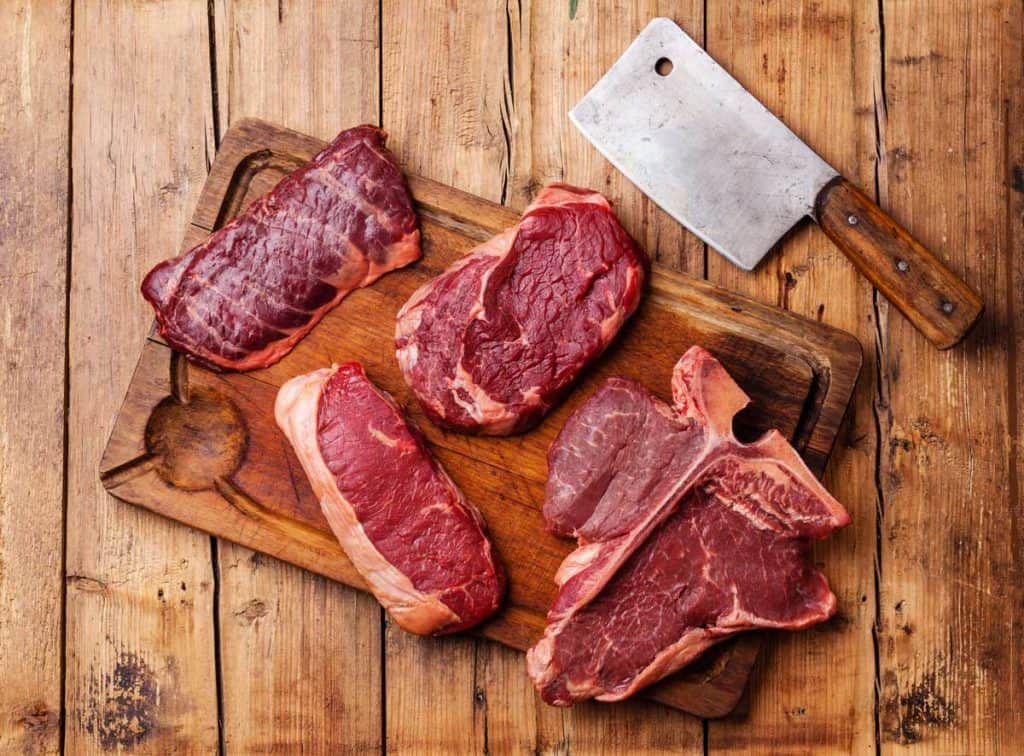
Understand Butchering Costs
When raising meat, it’s always most cost-effective if you can butcher and process the meat yourself.
Taking a few courses on butchering meat can go a long way in building your confidence. It’s not as complicated as it seems.
If you’re going to use a butcher, we recommend getting on their list well in advance, as we’ve heard of butchers being booked out for two years! Be sure to check out this post on what you need to know before butchering day, so you’re fully prepared.
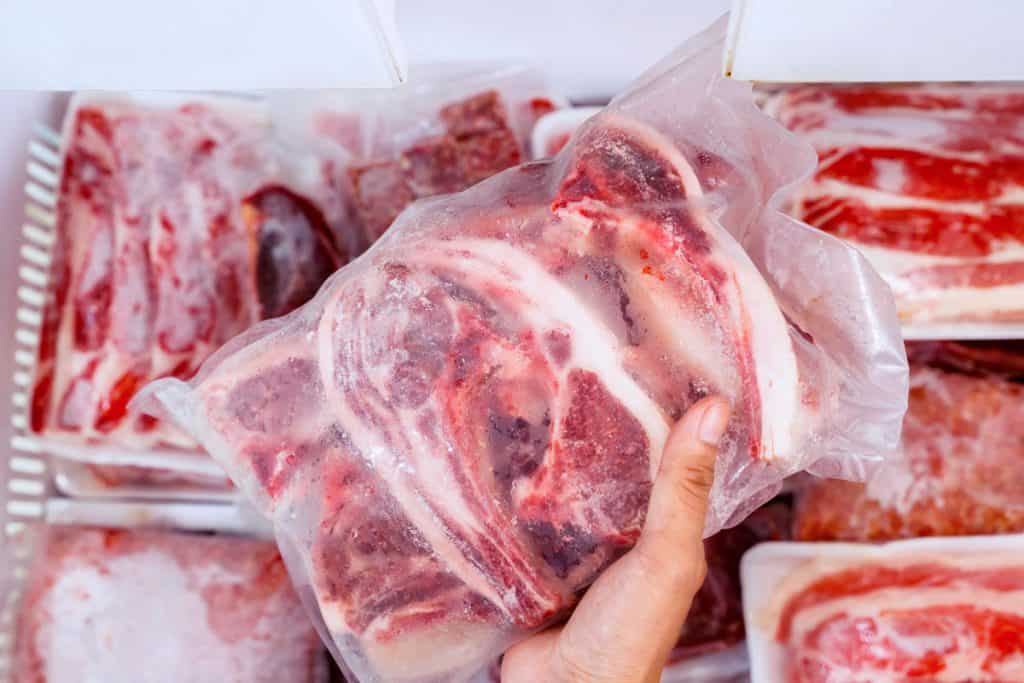
Options if You Can’t Raise Meat
Not all of us are at a place where we can raise our meat. If this is you, we encourage you to source your meat from a local farmer. Do your research to ensure they follow the farming and feeding practices you agree with.
This can be a great way to help support local businesses, build your local economy, and fill your freezers with good, high-quality meat.
When more local farmers know families want to buy a quarter, half, or whole animal, they can increase the number of animals they raise each year, which helps build up sufficiency within communities.
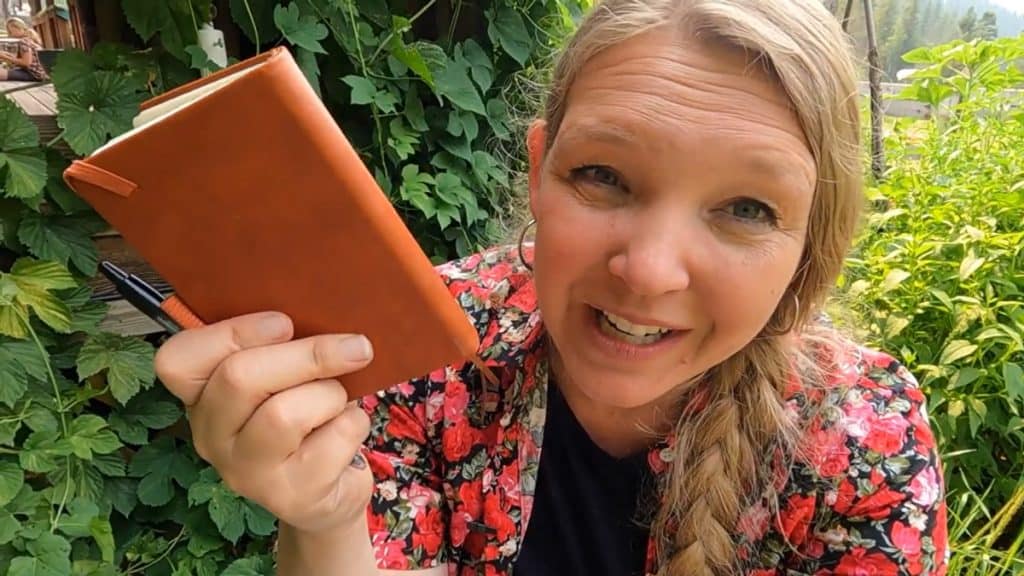
Keep Records
In everything we do here on the homestead, we always want to keep records to see what’s working and what’s not. Then, we can make appropriate adjustments based on data instead of guesses.
One way or another, start coming up with a plan for how to get or raise a year’s worth of meat. Grocery store prices are only rising, so figuring out where to start now is best!
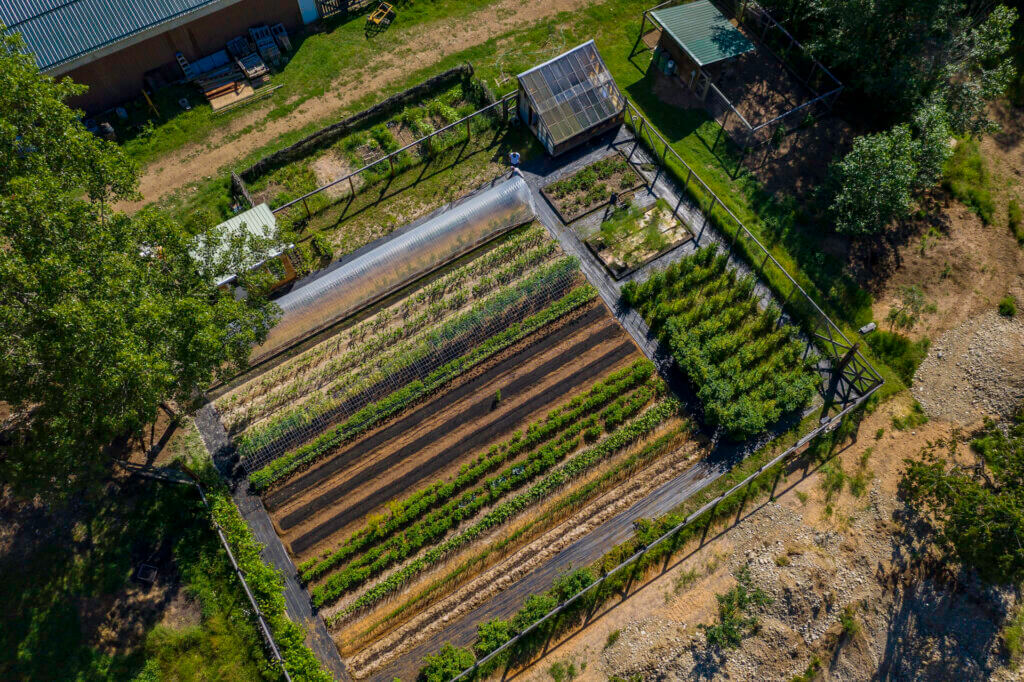
More Posts You May Enjoy
- Mineral Supplements for Livestock
- How to Save Money on Animal Feed
- Nutritional Benefits of Organ Meats and Cooking Tips
- Raising Goats 101: For Dairy with Anne of All Trades
- Building Resilience with Justin Rhodes
- How to Grow a Year’s Worth of Food with Melissa K. Norris
- Health Benefits of Going Off-Grid (Off Grid with Doug and Stacy)
Josh: Hey you guys. This is Josh.
Carolyn: And Carolyn.
Josh: With Homesteading Family and welcome to this week's episode of the Pantry Chat: Food for Thought.
Carolyn: This week we're going to talk about how many animals you need to raise for a year's worth of meat. I've had to figure it out.
Josh: Right. And that is not how much meat. We've got another Pantry Chat on that you can check out. This is how many animals you need to get to that amount of meat.
Carolyn: Yeah, we'll help you work through the equation because it is kind of a math equation, isn't it?
Josh: It really is, and it's actually kind of fun to do and it really helps you get your homestead dialed in and knowing ahead what you need to raise and plan. And of course you'll blend that with what you can raise and what you want to raise depending on your land and your wishes. But it's really a fun way to go that helps you kind of dial in what you're raising for yourself.
Carolyn: Well, and even if you aren't raising the animals yourself, this is going to help you know what you need to bring in from a local farmer. If you're buying a whole or a half animal, it's going to really give you a picture of your meat consumption for the year if you're trying to get ahead and buy that bulk or raise it yourself. So it's not only for people who are raising them themselves, but just to give you a good picture of what you need to purchase even.
Josh: Sure. Or if you're even looking at land and you're thinking about, I want to raise animals, I want to raise all my own meat. Well, if you know how much meat you need to raise, you can know how many animals you need based on what we're going to talk about today, which can help you look at land. And that's a different conversation about how many animals can you raise on that land? What kind? Even going to help you think ahead if you're looking to buy property eventually and you want an idea, how much land do I need in order to provide all of my meat for my family?
Carolyn: Hey, that sounds like a good follow-up Pantry Chat.
Josh: Sure does.
Carolyn: I think we better talk about that one soon.
Josh: All right, well we'll get to it. But for today-
Carolyn: For today.
Josh: We'll get to that in just a moment. Of course. We're going to always check in a little bit, see how things are going and answer questions. So how are things going? What's up with you?
Carolyn: Oh, things are going well. Just humming along in January.
Josh: It's almost over already.
Carolyn: Can you believe that? Almost over. We're actually filming this a little bit early and one of the things we are facing right now is we've just come through a really large winter storm. We got, what would you say, 18 inches of snow in about 48 hours, maybe a little bit more.
Josh: Yeah, 16, maybe 18 in the last couple of days. Yeah.
Carolyn: So that's been a lot of fun. Homestead's really taken that very well aside from a little extra plowing that the guys have been doing to keep the driveways clear and the walkways clear. But what we're really facing coming up here is some pretty severe negative temperatures on the forecast.
Josh: For us. Now our Canadian friends are going to laugh at us that we think this is severe or maybe our friends in Minnesota, but it's pretty cold.
Carolyn: For us, we're looking at some lows that are around negative 24 degrees Fahrenheit and one day in particular where we're not even coming out of the negatives as a high during the daytime. Negative four is the high.
Josh: Wow. I saw three days where the highest was negative three.
Carolyn: They were definitely hovering around zero and somewhere in there-
Josh: That's cold for us.
Carolyn: That's cold. That gets to be really cold and that starts needing some special considerations on the homestead. One, keeping the fire going. Sometimes that means we have to actually get up in the middle of the night to keep the fire going because there is no backup heat in our house at the moment.
Josh: Love wood.
Carolyn: We like our wood and it's a good thing it's there, but sometimes you have to nurture it along a little bit more. And then what about the animals?
Josh: Mostly it's just managing the water system. Our animals are great. Animals are hardy. What they need is just shelter and protection from wind and by shelter I mean they just need something a little bit over them. And protection from wind. Pigs need a little bit more cows, and sheep can actually stay in it if they've got a low spot to get into a tree. So animals-
Carolyn: They often prefer staying in it. You give them a nice barn, nice cozy spot and you'll come out and they'll all be out in the winter.
Josh: The cows are out in the barn yard, even in the snow and cold like this. But mostly it's just water, keeping the water. And we have de-icers, but even in that kind of weather, sometimes it's slower or of course it always happens, things fail. So de-icers start failing when it gets really cold. So that's probably our biggest challenge. But we're pretty squared away and ready for it and snow, the amount of snow is the biggest challenge. It creates a lot of plowing.
Carolyn: And up where we're at, it creates a lot of power outages. So that's been one of the things I've been managing for the last couple of days a little bit more is the inside of the house with power going off and then them restoring power and then an hour later it goes off again. We had a day yesterday of a lot of power on and off, on and off. Luckily we have generators to be able to switch on and kind of power up all the crucial systems, but it does require watching some lighting and lack of battery lighting and things like that.
Josh: Especially if you're, we don't have an inline where it comes on and off automatically, that'll be the next stage coming. So you got to go in and go out, turn it on and power comes back on. And so we had one of those, you had one of those days I was in town where you just got to mess with that. But it's nice. It's nice to be very set even that everything's taken care of well. And so we upgraded our generators this year to where they actually are turnkey so that Carolyn and the girls, particularly if all us guys were gone, weren't out there trying to pole start an old motor that just got its quirks, doesn't want to go right away and they're getting frustrated. So got some new Honda Motors with a key start and I know that makes it a lot easier to manage that.
Carolyn: It's a huge difference when all of a sudden you can just make something work without fighting it. It's a big difference.
Josh: So a little bit of a luxury, but it's very, very nice and on the step towards an interventional inline backup system.
Carolyn: So aside from the weather around here, I've just been getting into a little bit of garden planning, starting to think about seed starts and going through seeds, making sure we have what we need. We still haven't sat down and done all of our planning we normally would've done, but we are going to do it here.
Josh: Well, for us it's generally not too hard because our garden, we are going into our fifth garden year here-
Carolyn: On this property.
Josh: Obviously our 18th garden year in general as a couple 18th, 19th or more. And so we generally kind know where we're headed in what we're doing. And the way the garden maps out though, we're talking about a few changes this year to simplify a little bit. So still got to button that down.
Carolyn: Lots of planning to do. And I think aside from that, we're just kind of buckling down on homeschooling. We kind of talked about that last time, doing a little more homeschooling, a little more organization projects in the house, some organizing areas to get them a little bit more efficient, a little cleaner. Last time you noted the back wall over here and I've got to say it is a little bit better, but it's not totally organized at this point. So we're getting there. But January, February seemed to be the real time for that where we can really dial it in. But what about you? What have you been up to?
Josh: Well, we really kind of covered it. I think plowing is taking more time. We've got a bit of property, two houses to get to and barn access and we don't have to do all that much, but I kind of live by the idea that if something can go wrong, it will. So I try to keep things plowed pretty well when we've got heavy snow just so we have access everywhere. If we've got an animal emergency, we need to get a vet in, it's not a problem. We could just walk back and forth to the barn, but same with vehicles in and out. So plowing takes up a bit of time and just kind of planning and cruising along here.
Carolyn: The January sorts of things.
Josh: Thinking about 2024 and what are we going to do? That's the other discussion we haven't had yet is we actually just had our homestead huddle, which is where we get together with everybody in the family and talk about what's working, what's not working, what are particular interests, what would people like to do, what should we do more of and get everybody's input on systems that are working, not working well, need improvement. Do we need to abandon something? So we just kind of did that and now it's time for you and I to synthesize a bit and look at that.
Carolyn: Plan the year based on some of that.
Josh: Yeah. Yeah. And then also our big projects, I mean we've got pantry chats on this as well, on planning, dialing in our big projects so that we set goals that might push us a little bit, but that are doable and not overly stressful, which is what we tend to do is create more work and get stressed.
Carolyn: But you would think sitting down with all of the kids and asking them, is there anything we should do less of or not do, being that they do chores around here, they make this homestead run in a lot of ways. They do a lot of the work. And so you would think that they would be like, "Oh, let's just go to the grocery store and buy canned food and get our chicken from the grocery store and not do any of these." And when we asked that question, they were like, "No, we've got to keep doing it all."
Josh: Yeah, I even suggested are there any animals that we need to take out of the loop? And there were an individual here and there that maybe would be happy to do without a particular animal breed, but by and large the group was like, no, we need those. No, we like our lamb, this or that. And that was really, really cool. I guess it also was really cool and going through that, that the kids brought up is that they actually asked to watch less TV.
Carolyn: They did.
Josh: Now we don't watch a lot of TV as far as whatever normal goes, but when wintertime comes, it's time for rest. And so we tend to watch a little more in the evenings and it's usually something learning or something spread out with a little bit of entertainment, but sometimes mom and dad are a little tired and default-
Carolyn: [inaudible 00:09:52].
Josh: ... to what's easy. And the kids, all of them actually said, "Can we do less TV and do more reading or more activities?" Or more things. I was so proud of that and just how cool that was that they were asking us to do less.
Carolyn: That's pretty cool. Because you and I were both raised in front of a TV.
Josh: A lot of TV.
Carolyn: And so for us, when we get tired, when we get stressed-
Josh: It's easy to default to.
Carolyn: ... That's the easy default because that's what
Josh: Yeah, let's put on YouTube and learn some homesteading stuff or something we like or watch an animal channels, one of our things to do.
Carolyn: Yeah. We're very selective about what we watch, but sometimes we can watch more of it, especially in the winter than even we would like. And so kind of neat to see them who they've not been raised in front of the TV nearly as much and they're kind of going too much screen time.
Josh: Well, it's interesting because that's coming from the older ones that are doing school and they do school on their computers.
Carolyn: Yes, they do.
Josh: Because that's more efficient and that works well. And so they're like, "No, I've had enough screen time for today. I want to do something else in the evening."
Carolyn: Good.
Josh: So very good. I was proud of them for that.
Carolyn: Okay, well we're chatty today and we have a big topic to cover, so let's get to a question of the day.
Josh: Sounds good. It looks like this question is from one Peter 477 on a whole year's worth of lard in one day. Let me say that again. A whole year's worth of lard in one day.
Carolyn: Right. It's an older video.
Josh: Why is rendered lard not a botulism risk?
Carolyn: Good question.
Josh: To jar seal, even though they aren't canned. So there's somewhat of an oxygen free environment present, correct?
Carolyn: Yes. This is a really good question because you take that lard and the rendered lard and you can seal that in a jar. You seal it just because it's hot when you put it in there so it naturally seals. And of course we're told all the time, don't just seal the jar and put it on the shelf. You have to actually process it. The thing with lard is that it's all fat. And I know it's easy to look at fat and think of it as moisture, but it really isn't. There isn't a water content. It has pretty much zero water content in it. Botulism needs at least 14% water content in order to actually live and survive.
So when you have properly rendered lard that you've rendered out all of the liquid in, all that water in, then botulism cannot survive in that environment. So actually fat is actually a very safe medium to store things in, to preserve food in. That's why they used to do potted meats where you would cook the meat in the fat and then you would store it. You can still do that. It's actually really good. But then you store it covered in fat and that seals it in because you've kind of rendered out all of that liquid. Now you have to do it the right way in order to make it safe.
Josh: We're going to learn that one day.
Carolyn: But we have actually done a little bit of it in the kitchen. It's absolutely delicious and a good way to store some meat, but that's why it's safe is because it has no moisture in there. Yeah.
Josh: Very cool. All right, well we're going to get to subject of the day, but I want to address something real quick first and that is that some of you called out that I came to the pantry chat a little underdressed a couple of weeks ago. So I'm sorry.
Carolyn: What?
Josh: Please forgive me. I was without my hat and so I was not-
Carolyn: He does have hair.
Josh: ... Was not properly dressed. I do. It's not because I'm bald.
Carolyn: We have heard speculation that it's because you have no hair that you wear a hat.
Josh: I get a little self-conscious about my forehead. But anyways, Redmond noticed-
Carolyn: Nice forehead.
Josh: That I was without my hat and they sent me a nice shiny new hat. And if you guys aren't familiar with Redmond, make sure and check them out. Salt is integral to our life, to our animal health, and everything else.
Carolyn: Oh, that's funny. We love Redmond. That's cool they send you a hat.
Josh: Yeah. So anyway, sporting my new Redmond hat and I will be careful to come properly dressed to the pantry chats in the future.
Carolyn: That's good. We've used Redmond salt for-
Josh: Near 20 years.
Carolyn: I think 20 years. And I love that stuff.
Josh: Yeah, I do too. I've become friends with a couple of people there and just a great, great product. It is really in our opinion, you can get lots of good quality salt, but Redmond's all American made and it is American harvested, whatever, but it's done well. It's real and it's good quality.
Carolyn: Just you guys know this isn't a sponsor spot. Redmond hasn't paid us to say anything about it.
Josh: No, not at all.
Carolyn: We really like Redmond. It's the salt that we prefer to use.
Josh: Absolutely. We love sharing the things that we like.
Carolyn: Cool.
Josh: Alrighty. How many animals do you need to raise in a year to fill your freezer with the meat that you need?
Carolyn: Right. Wow. This is a big topic because I know we have talked before about how to figure out how much meat you need and we'll touch on that really lightly again today.
Josh: But you can check out the other pantry chat on that.
Carolyn: Yeah, we'll put that in the description.
Josh: This video mostly assumes that you know my family as a whole needs 1,500 pounds of meat for a year in total.
Carolyn: So taking that number then though and translating that into, so what does that mean for how many animals I need to raise or how many animals I need to buy from the rancher or the farmer becomes a whole next step. And when you start breaking these things down, it actually becomes very formulaic and it helps you to think through things. It becomes much easier when you first start switching over from buying by the cut meat in the grocery store. Thinking about purchasing a year's worth of meat is mind-blowing. How do I figure this out? How do I arrange it, how do I store it? All these different things. But then when you want to take it a step further and you're like, okay, now I want to raise this meat all by myself, what does that translate into, into animals? That can be very, feel very overwhelming to try to figure that out. So we're going to demystify that whole process for you today.
Josh: Absolutely. It's a little bit of guesswork and a lot of math, but it will really give you some confidence moving forward.
Carolyn: Well, and I want to say right now there will be a blog post just about this. So if you're the kind of person who you're hearing the math and you're like, "Oh my gosh, I wish I could see this in written form." Check out the show notes. We will make sure to have a link for you there so you can actually see it in writing.
Josh: Very cool. All right. All right, so where to start? You know you need X amount of meat in a year. I think our examples is one for our own family, which is a little over 1,500 pounds, that's probably high for most people. We'll get to another example that's a little bit less than that. More like 625 pounds. Where to start? So we're going to start with poultry and chickens because one, it's something that's easy for people to raise. It's a good place to start raising your own meat and there's two ways to go. You can just figure out per bird how much you need, which is what we're going to tackle here.
Carolyn: Meaning I'd like to eat one chicken per week for my household. And so you go per bird instead of poundage.
Josh: And that's about it. How much chicken do you need? You need one bird, you need three birds a week times 52, and that tells you how many birds that you need to raise.
Carolyn: Give yourself some padding on that number. You will lose animals somewhere, especially with meat chickens. So 15%, 10, 15% padding and then round up to give yourself a little bit of room in that process.
Josh: But based on that number, I need 1,000 pounds overall you need to be able to estimate each chicken is average five pounds. Therefore do the math, take that out of your 1,000. So you do need to do that math. The other way you can figure poultry is figure it into the equation that we're going to go through next is your overall meat source, which we'll go through. That's another way to do it, but just usually, no, that's how Carolyn figures it usually. No, we need a chicken a week or we need three chickens a week.
Carolyn: For us it's three chickens a week at least right now, and then round up a little bit for our large family. Okay, so in this, if you pull out the chicken count because you're just doing it by bird, because that's an easy way to think about it if you're in the kitchen.
Josh: Which goes to by day is what that leads to.
Carolyn: It is by day. Well how much chicken per week.
Josh: So you are eating chicken one day a week.
Carolyn: Oh, by day. Yeah. So one day. Yeah, one day out of the week, two days out of the week. How often, how much chicken do you need then to get through one day and then how many days a week do you want to eat it? And then go ahead and multiply that out.
Josh: Right.
Carolyn: Yeah.
Josh: And then that's going to lead you to your total meat weight minus chicken based on what we're talking about here.
Carolyn: Okay, so wait, sorry, I was still summing up poultry here. So you're talking about for knowing how much meat you need in general, you want to look at how much you're going to eat in a day, right?
Josh: Right.
Carolyn: That's pretty the basic way to do it. And then you're going to multiply that out by how many weeks and how many months, get yourself to that how much you need per day, but over the whole year for your whole family.
Josh: And that gives you that total.
Carolyn: It gives you that total.
Josh: You want X amount of meat.
Carolyn: Yeah, so. Right.
Josh: So a few things to know here. There's a few terms before we get into the math that you want to understand.
Carolyn: These are important terms to know because as you start figuring out your weight, you realize that meat weight that you're thinking about, I need three pounds a day to get my family through. You can't just say, "Hey, well then I need to raise three pounds of meat over here." Because there's a lot of different things that happen in the processing of getting that animal to that cut and package weight.
Josh: A live animal weighs much more than what you get in the freezer once that animal's been processed. So we need to talk about three things. Live weight, hanging weight, and cut weight.
Carolyn: Those are the three different things. So live weight is obviously what it sounds like. It is the live weight of the animal before it has been slaughtered or cleaned or anything's been done to it.
Josh: And knowing averages and live weight's going to be real key to some of the math on things we're going to do here.
Carolyn: Okay, so we'll talk about those averages in a minute.
Josh: Right. Next is hanging weight. Hanging weight is after the animal has been killed and has been eviscerated. That means it's been gutted, its skin's been taken off, usually its head has been taken off and that's that hanging weight what's actually going to get cut up into your cuts of mean. So it's important to know hanging weight, you often get charged from the butcher based on hanging weight, a few different things like that. But again, that's not what goes into your freezer.
Carolyn: You still have some more loss coming up from that.
Josh: There are some places in the country that refer to this as hot carcass weight. That's like the technical industrial term. Some custom butchers use that. So if you hear that, just know that that is what we're calling hanging weight.
Carolyn: Yeah. Some of these have different terms in different areas.
Josh: Yeah. And I'm sure we're not familiar with all of the terminology in different places, but hanging weight's the most common. We've lived in several different places around the country, talked to a lot of people, and so hanging weight's what you'll generally hear from a custom butcher.
Carolyn: Okay. Then your final weight here is your cut weight. And that is if you take all the little nice weight packages that you're going to get back from the butcher and you add all those up, that is your cut weight.
Josh: And that's that, how much meat do you need for a year, right? That's your cut weight. You might hear it as your take home, your packaged weight, your cut and wrap weight there. Again, there's even more terminology for that, but we're going to refer to it as cut weight here today. And that is actually what's getting you to that, I need X amount of meat year as your cut weight.
Carolyn: So the real trick here is trying to figure out the difference between that live weight and that cut weight so that you can kind of reverse engineer it and be like, "Hey, this is how much cut weight I need at the end of the day to feed my family for a year. So how much live weight do I need?" Now luckily there's some industry standards, some we've got to say right off the top, all the numbers in this are average standard.
Josh: We have to have a way to talk about it. We got to have a way to talk about it. So they're averages. And as we go through them, I'll talk a little bit about the fluctuations, but they are averages, and this is going to help you understand if you're raising an animal, it's an average cow, you kind of know what its general live weight is. You can do some percentages here. So we're going to cover the three main animals that people are doing beef, pork, and lamb.
Carolyn: Okay, good. So if you have your animal, your beef, and you have its live weight, you can expect about 46%. Is that 46?
Josh: Sorry, that's 41.
Carolyn: 41, sorry.
Josh: Sloppy writing.
Carolyn: 41% of that live weight to end up in your freezer as your cut weight,
Josh: Right. So if you have say a 1,000 pound cow steer, about 410 pounds of that is going to be packaged meat in your freezer. So a few caveats, we'll get to that in a moment. It kind of goes across all animals.
Carolyn: Okay, sounds good.
Josh: So pork.
Carolyn: So pork, you have a higher yield with pork and you're going to get about 53% of your live weight into those cut packages. And then with the lamb, you're going to get a much lower percent percentage. We'd say lamb, venison would be kind of the same if you're thinking about hunting and bringing deer, elk in. Then with lamb, you are looking at more like 35% of your live weight ends up in your freezer.
Josh: Now a few things that affect this. One is just the breed of animal and it will fluctuate between breeds, even meat breeds. So it can go up and down a little bit. Most of these I'd say are probably the low end. You're probably not going to do much lower than that unless you have an unhealthy animal or unless you exclude a lot of bones, which we'll talk about in a second. So this is probably a low end. So there's the breed of animal, there's how the animal is finished, how it was raised and finished. Is it fully filled out and finished properly? The more properly it's finished and aged, aged on the hoof as far as being alive and taking the maturity, that's going to increase that a little bit as is how you cut and wrap.
Carolyn: We have had the experience of when we do it ourselves in our own home, we get a much higher yield. It's just kind of the way it is. You're dealing with your own, you're not going to waste anything. But when you send it off to the butcher, you also have variables in your cut list and what you might want back that are going to affect that yield number.
Josh: So the other one is just bones, and depending on how you cut it up will determine how many bones are in it. And when we're talking about this, because we're coming from a homesteading perspective, we're assuming there are bones in there. So we are often taking cuts that might have a higher percentage of bone weight than, say, store-bought meat. And so when we're figuring our household need over the years, say 1,500 pounds, we're figuring there are bones in that. And so-
Carolyn: Some bone, not all the bones.
Josh: Not all the bones, but some bones. So that's just important to understand because that is going to push your weight up a bit. So when you're talking beef, 41%, that's the low end, it can be up to 50%, sometimes even a little bit higher. Pork the same. It can be 60% or a little bit higher. And lamb to me in my experience, have been a little more variable. Sometimes it's actually lower, sometimes it can be a little higher, but I'd say the lamb number is probably closer to reality. But know that these are rules of thumb, they're guidelines, but they'll get you there. They'll get your planning, and then as you do this for a year or two, you'll get to where you just start to know and it starts to work out. But this really helps get you going if you go by those percentages.
Carolyn: Okay, so let's say we now know how much meat we need to end up with in our freezer pound wise, and we understand the difference between the live weight and our cut weight and how to figure that percentage based on the percentages we just gave you. What is our next step for figuring out how to figure how many animals we need or what animals we need from that knowledge?
Josh: So the thing that you can do is kind of take a rule of thumb that says is a third of the live weight in actual meat. So reverse engineer that. If you need 1,000 pounds and I'm just using 1,000 because it's easy on math, right?
Carolyn: It's easy math.
Josh: If you need 1,000 pounds of meat in the home, then you're going to want about 3,000 pounds of live weight animal. We will get to breaking that down in a minute, but that's a very rough guideline. These percentages actually are higher than that, but that kind of keeps it secure, keeps it safe, and make sure that you're raising enough animals.
Carolyn: It gives you a starting spot,
Josh: Right. Gives you a starting spot.
Carolyn: So in the example you just gave, let's say you need 1,000 pounds of meat, you decide, okay, I'm going to raise then, by that really rough rule of thumb, I'm going to raise about 3,000 pounds of meat.
Josh: Right. Remember, this is not including chickens.
Carolyn: This does not include chicken. This is why we broke out chickens at the beginning.
Josh: Well, and a good reason for that is it's just live weight on chickens. We're not usually talking about it that way. Yeah.
Carolyn: So now you say, okay, I need about 3000 pounds of meat, live weight. Where do you go from there?
Josh: So well, you need to know what are the average size of animals if you just get in your head around this. And so you can do a little bit of math. So we've got some average. Again, these are averages, these fluctuate.
Carolyn: And these are really based on commercial meat breeds. Just to tell you, if you're raising a heritage breed animal or something like that, you're probably going to expect a little bit smaller of a live weight. So you want to, as you refine this process, you're going to want to really get into the exact breed of the animal that you're raising.
Josh: And you'll be able to find averages for that breed. If you know you've got a breed, that's what you can buy locally. It's what you like, it's what works well on your land. Just do the research and you can plug and play in these numbers. Whatever you have, any breeder, any research on the breeds going to tell you what the averages are.
Carolyn: About what to expect. Yeah.
Josh: Okay. So average meat breed. So lamb on average runs about 120 pounds.
Carolyn: This is live weight.
Josh: Live weight.
Carolyn: When they're finished ready to go.
Josh: Goats, which we're not really breaking down, but they're running about 60 pounds. Wow. Okay. I would guess they'd be a little heavier than that. Interesting. But I don't know goats well at all. Beef, 1,200 pounds, that's definitely a little on the high side for most heritage breeds. And then pork, about 250 pounds. So you can do some math right there. I need 3,000 pounds of live weight. And you could say, "Well, I'm going to do one beef at 1200 pounds. I'm going to do four pork at 250 pounds." That's 2200 pounds and you need 800 more pounds to do the math on the sheep. You need about six sheep there or something, right? And you can plug and play those numbers and that starts to give you an idea of what you need on the hoof on your land to get to that a 1,000 pounds.
Carolyn: So you can see how that becomes really kind of formulaic, right? It's like it really breaks it down into the formula. The kinds of animals that you choose are going to depend on what do you want to eat? What do you have room to raise, what do you have infrastructure for? What do you have access to with your local rancher that you want to buy meat from? But you can start saying, "Look, I can only get beef. That's the only thing I have access to. So I just want all beef." Well, you know, you have that number that's going to help you dial in roughly about how many of each, but you don't want to leave it at that rough number once you start dialing in this like, okay, maybe I want two steer, four pigs, and one sheep. You don't want to leave it at that rough number that was based on that triple your package weight or your cut weight. You want to go back and run the actual percentages again. Remember the ones where we're talking about beef is 41%, pork is 53% and lamb is about 35%.
Josh: And we'll run a couple scenarios here, but also you can do this based on what your wants are. Say you want to eat a diet that's about 30% beef and 20% pork and 30% lamb and the rest chicken, you can play with those numbers and come up with a percentage of your overall meat needs and work it that way. So there's a couple different ways to do this, but we're going to talk about our family. So for a family of 15, we need about three chickens a week for a day's worth of meals. So 52 times three is 156 plus a little bit for loss.
Carolyn: A little bit of padding.
Josh: A little of padding. So that gives us 172. Generally you're rounding up ordering by 20 fives and batches. So that's 175 chickens in a year.
Carolyn: Right. No wonder we have a chicken full of freezer, freezer full of chickens,
Josh: Freezer full of chickens. Good thing we don't have a chicken full of freezers.
Carolyn: That would be bad.
Josh: Let's see. Now for the rest of the time, we need about five pounds a day and that's for six days a week as we're covering that one day a week with chickens. So that's about 30 pounds a week. Times 52 is 1,560 pounds of meat a year is-
Carolyn: What's the cut weight. Don't panic. We have 15 people generally at our table if we average it out. So this is probably not your scenario. You probably don't need the about a number that Josh is about to say here. I don't want you to panic.
Josh: So going by that rule of thirds, just to give us a rough draft. So you times that, times three, that gives you a 4,680 pounds of live animals that are finished and ready to go to butcher. Okay? So what do we need? Well, we've covered the 175 chickens. We're going for two 1,200 pound steers, four 250 pound pigs, and 100 pound sheep. Okay? That's going to get us to that live weight.
Carolyn: Right about that live weight.
Josh: Good. And that breaks down real nicely. If you take those percentages I gave you, those two 1,200 pound steers are going to yield 984 pounds of beef, roughly. The pork is going to 530 pounds of pork and the sheep about 42 pounds of lamb. That gives us 1,556 pounds of meat, right at our target there of 1,560.
Carolyn: Very nice. Okay, but what about a more reasonable family of four? That's a much more normal situation who only wants to eat about one chicken a week for the family and they want to consume about half a pound per person of meat per day on the remaining days of the week.
Josh: And don't freak out about the half pound. I know you might say, whoa, we don't need a half, we eat a third pound or a quarter pound. But remember there's bones in there, there's a few different things. Average up a little bit. So I think a half pound is a good rule.
Carolyn: Some people feel like that is light, some people feel like it's heavy, people's preference is all over the place.
Josh: Kind of depends how your diet is, but just round up, so sure. So that's 60 chickens, by rounding up.
Carolyn: Yeah, you round up a little bit. So 60 chickens.
Josh: Then that means you need 12 pounds a week times 52. That's 624 pounds of meat a year. so we've broken this up with one steer at 1,200 pounds.
Carolyn: So first let's do the-
Josh: Oh, sorry.
Carolyn: If they multiply that by three, then they're going to end up needing 1,872 pounds of live finished animal.
Josh: Right. Which really isn't that much. We're talking four animals here. When you break it down, one steer, 1,200 pounds, roughly, two pigs at 250 pounds. You generally want two pigs anyways and one sheep at 120 pounds. Go ahead and get the second sheep. They need a buddy. They need a buddy. But for the sake of the math, that yields 504 pounds of beef, 132.5 pounds of pork, 42 pounds of lamb, getting us to a little over our goal, 678 and a half pounds of meat for the year.
Carolyn: Oh good.
Josh: So you're right in there.
Carolyn: All right, so that is a really rough way. And the fun thing about this is that you can start playing with the different types of animals that you want, right?
Josh: Right.
Carolyn: To get you to that number. Let's say you're that same family and you say, "We don't eat pork." Or we're not interested in raising pigs this year. You can then say, maybe you want that one 1,200 pound steer. Maybe you're planning on hunting and you're going to bring in a couple of 150 pound deer, that's very reasonable, and 3 120 pound sheep. And that's going to get you up about to that total too.
Josh: So that's where it's really cool because you can start to plug and play and you can even run different scenarios, again, based on the land you have or based on land you're thinking about buying or where it's at. And your land may be better for sheep, so you just need to do more sheep and you're going to maybe buy half a steer. I mean, there's just a whole lot of directions you can go with this to plug and play to help you confidently start out the year raising what you need. And it's not an exact science, but this is going to get you very close. And then you just adjust year over year.
Carolyn: Make sure you keep records of what you did, what your plan was, and then in retrospect how that worked for you. Like, oh, we ran out of chickens too soon or we had way too much whatever, we didn't like it. And that way you can adjust in the following year.
Josh: And same with your animals. When you're butchering them, try to know their weights, especially in the early years when you're figuring this out. Try to make sure the live weight, the hanging weight. A lot of times custom butchers don't give you the cut weight. That's one of the reasons I like doing at home. We weigh everything. But it's okay. You need to use a custom butcher that just may be something you don't have time for. So you may just want to weigh it yourself if they don't weigh the packages, but keep those records. That really helps you figure it out. Eventually you get down the road, you know your land, your family's needs, and you're more just adjusting and going, "Oh, we're going to do a little less chicken this year. We're going to do an extra lamb." Or, wow, our beef, something happened and we don't have one. Or it's just smaller this year. It's younger. We've got to harvest it younger. All that allows you to adjust and plan. Yeah.
Carolyn: Yeah. Very good you guys. So just get out a pad of paper and a pencil and start scribbling away and figuring it all out. Again, there's a link to the blog post down below in the description if you want to see all of those numbers again and how they work together, that'll help you right there.
Josh: And we'd love to hear the math for you. I'd love to know how much meat does your family need for a year and what are you planning to raise or buy to get there?
Carolyn: Oh yeah.
Josh: What a fun discussion. So drop that in the discussion if you'd like to.
Carolyn: All right, it's been great hanging out with you.
Josh: See you soon.
Carolyn: Goodbye.
Josh: Thanks for listening to this episode of The Pantry Chat: Food For Thought. If you've enjoyed this episode, please subscribe, rate and review
Carolyn: To view the show notes and any other resources mentioned on this episode, you can learn more at homesteadingfamily.com/podcast.
Josh: We'll see you soon.
Carolyn: Goodbye.
Sign up to receive email updates
Enter your name and email address below and I'll send you periodic updates about the podcast.

